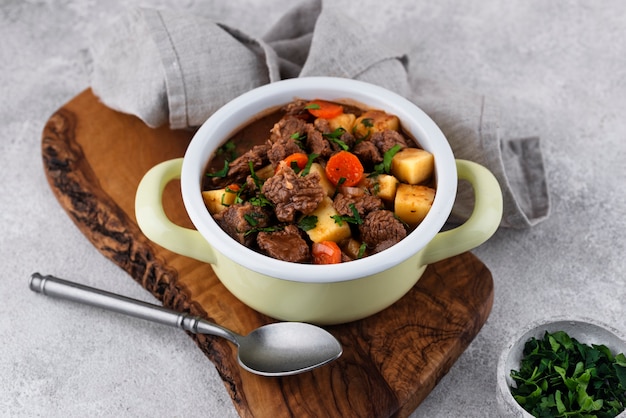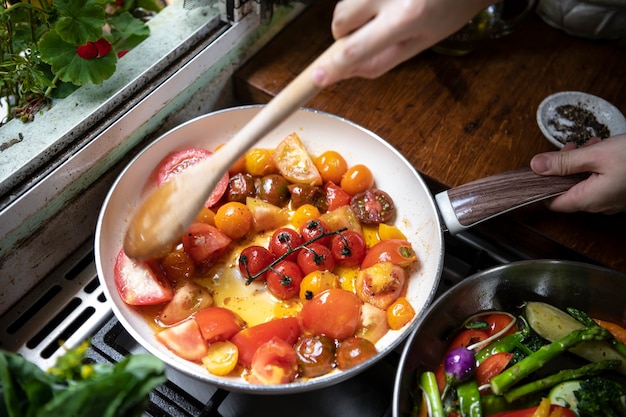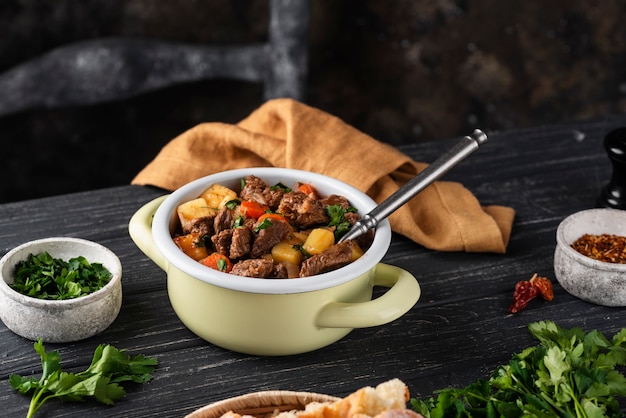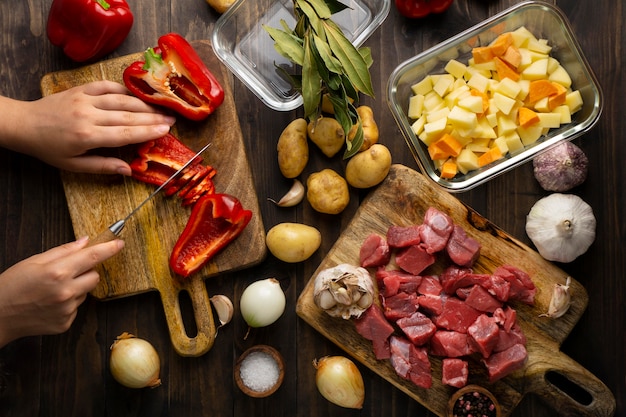There's something incredibly comforting about a hearty bowl of beef stew on a chilly evening. The rich, savory broth, the tender chunks of meat, the medley of colorful vegetables – it’s a true culinary hug in a bowl.
Over the years, I've made countless batches of beef stew, experimenting with different cuts of meat, vegetables, spices, and even cooking methods. Through trial and error, I've finally landed on a recipe that’s become my go-to, a recipe I proudly share with friends and family. It’s the kind of beef stew that makes people ask for seconds, and maybe even thirds!
So, get your apron ready, gather your ingredients, and let's embark on this culinary journey together.
(Part 1) The Secret to a Tender and flavorful beef Stew: choosing the right cut

The first step to a truly delicious beef stew is selecting the right cut of meat. You want something that's going to be both tender and flavorful, and you don't want to spend hours braising it.
For years, I always used chuck roast. It's a budget-friendly cut with a robust flavor, but it can be a bit tough. You need to cook it for a good amount of time to achieve tenderness, which can be a bit time-consuming.
Then, I discovered the magic of short ribs. While they're a bit more expensive than chuck roast, they're absolutely worth it! They're incredibly flavorful and melt-in-your-mouth tender, and they don't require hours of cooking.
Choosing the Right Cut for Your Beef Stew: A Guide
Here's a table comparing different cuts of beef for stewing, helping you choose the perfect one for your recipe:
| Cut of Beef | Pros | Cons |
|---|---|---|
| Chuck Roast | Budget-friendly, full of flavor | Can be tough, requires longer cooking time |
| Short Ribs | Extremely tender and flavorful, rich in collagen | More expensive than chuck roast |
| Beef Shanks | Similar to short ribs, but more bone-in, rich in flavor | Can be harder to find |
| Brisket | Lean and flavorful, versatile for various cooking methods | Requires longer cooking time than short ribs |
Short Ribs vs. Beef Shanks: A Deeper Look
Both short ribs and beef shanks are fantastic choices for beef stew, but they have distinct characteristics. Short ribs are typically boneless and come in various cuts, including English-style (bone-in) and flanken (bone-in and thin, resembling a small rib roast). They’re known for their generous marbling, which contributes to their rich flavor and tender texture. Beef shanks, on the other hand, are usually bone-in and tend to be a bit leaner than short ribs. This leanness translates to a more intense flavor.
(Part 2) Prepping the Beef: The Foundation of Flavor

Now, before we jump into the cooking process, let’s get our beef prepped. This simple step plays a crucial role in creating a delicious stew.
Trimming and Cubing: The First Steps
First, I like to trim any excess fat from the beef. You can leave a little bit of fat for added richness, but too much will make the stew greasy. Next, I cut the beef into about 2-inch cubes. These cubes will ensure even cooking and allow the flavors to penetrate well.
Salting the Beef: A Culinary Debate
There's a bit of a debate in the culinary world about salting the beef before browning. Some chefs believe in salting after cooking to prevent the meat from drying out, while others argue that salting beforehand helps develop flavor.
Personally, I prefer to salt the beef right before browning. This helps create a nice crust on the outside of the beef, which adds a wonderful depth of flavor to the stew. However, if you're concerned about the meat drying out, you can always add the salt at the end of the cooking process.
Browning the Beef: The Essence of Richness
Browning the beef is a vital step in creating a truly flavorful beef stew. It's the foundation upon which we’ll build a symphony of flavors.
The Art of Browning: Step-by-Step
1. Heat a large pot or dutch oven: Start by heating a large pot or Dutch oven over medium-high heat. A Dutch oven is ideal for braising, as it traps heat and moisture, ensuring even cooking.
2. Add oil or butter: Add a tablespoon or two of olive oil or butter to the pot. These fats will help the beef brown properly and create a delicious crust.
3. Brown in batches: Add the beef in batches, making sure not to overcrowd the pot. If you overcrowd it, the beef will steam instead of browning.
4. Cook for 2-3 minutes per side: Cook the beef for 2-3 minutes per side, or until it’s nicely browned. Don't be afraid to let the beef get a little crispy. That caramelized crust is what we’re after.
5. Remove and set aside: Once browned, remove the beef from the pot and set it aside.
(Part 3) Layering the Flavors: The Vegetable Symphony

Now, it's time to build the foundation of flavor for our beef stew by introducing the vegetables. They'll add texture, sweetness, and a beautiful array of colors to our dish.
The Essential Vegetable Trio: A Core Trio
There are three vegetables that I consider essential to any good beef stew:
Onions: They add a sweet and savory depth of flavor that's irreplaceable. I always use a large yellow onion, and I like to slice it thinly so it cooks quickly and evenly.
Carrots: They add a bit of sweetness and a welcome crunch to the stew. I use about 2-3 large carrots, cut into 1-inch pieces.
Celery: It adds a bright, herbaceous note that complements the richness of the beef. I use about 2-3 stalks of celery, chopped into 1-inch pieces.
Expanding the Symphony: Adding Depth and Variety
Of course, you can always add other vegetables to your beef stew to enhance the flavor profile and create a more complex dish. Here are some ideas to inspire your creativity:
Mushrooms: Portobello mushrooms are especially delicious in beef stew, adding an earthy, umami flavor that's quite addictive.
Potatoes: Yukon gold or russet potatoes add a satisfyingly creamy texture and a touch of starch to the stew. Choose potatoes that hold their shape well during cooking.
Parsnips: They add a subtle sweetness and a hint of peppery flavor, adding another dimension to the stew.
Turnips: They add a bit of bite and a lovely, pale yellow hue to the stew, creating a visually appealing contrast.
Leafy greens: Kale or spinach can be added at the end of cooking for a boost of nutrients and a vibrant green color.
(Part 4) The Spice Rack: A Symphony of Aromatic Notes
Now, let's add those aromatic spices that will elevate our beef stew to the next level.
The Essential Spice Blend: A Flavorful Foundation
I always start with a basic spice blend that includes:
Salt: It's the key to bringing out the flavors of all the ingredients.
Black pepper: A touch of black pepper adds a bit of heat and spice to the stew.
Paprika: It adds a warm and smoky flavor, enhancing the savory notes of the beef.
Dried thyme: A classic herb that complements beef beautifully, adding a touch of earthiness.
Bay leaves: They add a unique, subtly bitter flavor that adds complexity to the stew.
Exploring Additional Spice Options: Expanding the Flavor Palette
You can always add other spices to your beef stew, depending on your taste and preference for bold flavors. Here are some ideas to explore:
Garlic powder: For an extra punch of savory flavor, especially if you enjoy a strong garlic flavor.
Rosemary: For a slightly bitter and woodsy flavor that complements beef well.
Oregano: For a slightly spicy and herbaceous flavor that adds a Mediterranean touch.
Cumin: For a warm, earthy flavor that adds a touch of exoticism.
Chili powder: For a bit of heat and smoky flavor, especially if you enjoy a touch of spiciness.
(Part 5) The Secret Ingredient: A Splash of Wine
Adding a splash of red wine to your beef stew is a game-changer. It adds a depth of flavor that you simply can't get from other ingredients.
Choosing the Right Wine: Don't Overthink It
You don't need to use an expensive bottle of wine. Any dry red wine will do. Cabernet Sauvignon, Merlot, or Pinot Noir are all great options. Choose a wine that you enjoy drinking, as the flavor will be infused into your stew.
Adding the Wine: The Deglazing Technique
Once you've browned the beef, add the wine to the pot and bring it to a simmer. This is the time to "deglaze" the pot, which means scraping up any browned bits from the bottom of the pot. These browned bits, called fond, are packed with flavor. Let the wine simmer for a few minutes, allowing it to reduce by about half. This will concentrate its flavor and create a delicious base for your stew.
(Part 6) The Liquid Gold: A Base of Flavor
Now it's time to add the liquid that will form the base of our beef stew.
beef broth or Stock: The Foundation of Flavor
I always use beef broth or stock for my beef stew. It adds a deep, rich beef flavor that's essential for a truly satisfying stew. If you have the time and inclination, make your own stock from beef bones for an even more intense and flavorful broth.
Other Liquid Options: Creative Alternatives
If you don’t have beef broth or stock, you can use water or even red wine as a base. However, I highly recommend using beef broth for the best flavor.
Adding the Liquid: Ensuring Coverage
Pour enough beef broth or stock into the pot to cover the beef and vegetables by about an inch. Make sure all the ingredients are well-submerged in the liquid.
(Part 7) Slow and Steady Wins the Race: The Art of Simmering
With all the ingredients in the pot, it’s time to let the magic happen. We’re going to simmer the stew until the beef is tender and the flavors meld.
Simmering Time: A Matter of Patience
Short ribs need to simmer for about 2-3 hours, while chuck roast needs to simmer for about 3-4 hours. The cooking time will vary depending on the cut of beef and the size of the chunks.
Low and Slow: The Key to Tenderness
The key is to cook the stew over low heat. You want it to simmer gently, not boil. A good way to do this is to use a slow cooker. It's perfect for making beef stew because it cooks slowly and evenly, creating incredibly tender beef and a rich, flavorful broth.
The Art of Patience: Embrace the Process
Beef stew is one of those dishes that really benefits from patience. Don’t be tempted to rush the cooking process. Let it simmer slowly and allow the flavors to develop. The longer you simmer the stew, the more tender the beef will become and the deeper the flavors will become.
(Part 8) The Finishing Touches: Adding the Last Notes of Flavor
Once the beef is tender, it's time to finish the stew and add those final touches that will elevate it to perfection.
Thickening the Stew: A Matter of Preference
If you want your stew to be a bit thicker, you can add a cornstarch slurry. To make a cornstarch slurry, mix together 1 tablespoon of cornstarch and 2 tablespoons of cold water. Stir it into the stew and let it simmer for a few minutes until it’s thickened.
Adding the Greens: A Touch of Freshness
If you're using leafy greens like kale or spinach, add them to the stew during the last 10 minutes of cooking. They'll wilt down quickly and add a lovely bit of green and a burst of freshness to the stew.
Salt and Pepper to Taste: A Final Adjustment
Finally, taste the stew and adjust the seasoning as needed. Add more salt and pepper if necessary to balance the flavors.
(Part 9) Serving Up a Feast: Garnish, Accompaniments, and More
Your beef stew is ready to serve!
Garnishing Your Creation: Adding a Touch of Finesse
Here are a few ideas for garnishing your stew, adding a touch of visual appeal and enhancing the flavors:
Chopped fresh parsley: Adds a bright, herbaceous touch that complements the savory flavors.
A dollop of sour cream or Greek yogurt: Adds a creamy, tangy element that balances the richness of the stew.
A sprinkle of grated Parmesan cheese: Adds a savory, salty flavor that enhances the overall taste.
Accompanying Your Beef Stew: Complementary Delights
Here are some ideas for serving your beef stew with:
Buttery mashed potatoes: The perfect creamy and comforting side dish that pairs perfectly with the stew.
Fresh crusty bread: Ideal for soaking up all the delicious juices and adding a satisfying crunch.
A simple green salad: Adds a refreshing and healthy touch that balances the richness of the stew.
Freezing and Storing Your Beef Stew: Making it Last
Beef stew freezes beautifully! Let the stew cool completely before transferring it to an airtight container and freezing it for up to 3 months. When you're ready to enjoy it, simply thaw it in the refrigerator overnight and reheat it on the stovetop or in the microwave.
FAQs
What if my beef stew is too salty?
If your stew is too salty, you can add a splash of water or beef broth to dilute the saltiness. You can also add a tablespoon of sugar or honey to balance out the saltiness.
What if my beef stew is too thin?
If your stew is too thin, you can thicken it with a cornstarch slurry as described above. You can also try reducing the stew by simmering it uncovered for a few minutes, allowing the excess liquid to evaporate.
Can I use a different kind of meat for this recipe?
Absolutely! You can use a variety of other meats for this recipe, such as chicken, lamb, or even venison. Just adjust the cooking time accordingly.
Can I make this recipe in a slow cooker?
Yes, you can make this recipe in a slow cooker. Simply brown the beef and vegetables as described above, then transfer everything to your slow cooker. Cook on low for 6-8 hours or on high for 3-4 hours. The slow cooker will create a wonderfully tender stew with deeply infused flavors.
How can I make this recipe vegetarian or vegan?
For a vegetarian version, you can substitute the beef with hearty vegetables like lentils or chickpeas. They'll add a protein boost and a satisfying texture to your stew. For a vegan version, use vegetable broth and avoid any dairy products like sour cream or cheese. You can also use vegan butter instead of regular butter.
This recipe is a great starting point for experimenting and finding your own perfect beef stew. Don't be afraid to get creative and add your own personal touches. Enjoy the process and the delicious results!
Everyone is watching

Perfect Rice Every Time: The Ultimate Guide to Cooking Rice
Cooking TipsAs a self-proclaimed foodie, I've always been a bit obsessed with rice. It's the foundation of countless cuisi...

Ultimate Guide to Cooking the Perfect Thanksgiving Turkey
Cooking TipsThanksgiving. Just the word conjures up images of overflowing tables laden with delicious food, the scent of r...

The Ultimate Guide to Cooking Asparagus: Tips, Techniques, and Recipes
Cooking TipsAsparagus. The mere mention of this spring delicacy conjures up images of vibrant green spears, crisp and burs...

Can You Cook Spaghetti with Gasoline? (The Shocking Truth)
Cooking TipsWe've all seen those crazy internet trends. You know, the ones that make you wonder, "Did someone actually try...

Chorizo and Eggs Recipe: The Ultimate Guide
Cooking TipsRight, let’s talk about chorizo and eggs. You know, that classic Spanish dish that's always a winner. It's th...
